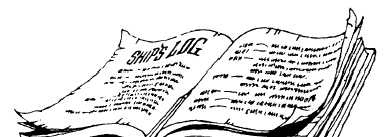| |
Engineer’s Bell Book
The engineer’s bell book is a chronological
record of orders pertaining to the speed of the
engines. The book contains a record of orders
affecting each shaft. It shows the time of receipt
of each order to change the propeller speed, the
meaning of the order, and the revolutions per
minute resulting from action taken in obedience
to that order.
SUMMARY
The structure of our shipboard organization
allows ships to operate safely and effectively.
Seldom do ships operate in exactly the same
manner, but all classes of ships have the same
basic organization. As new ships and new
technologies are developed, our organizational
structure will be adjusted to operate them
efficiently.
One thing that will never change, however, is
the chain of command. Someone will always be
ultimately responsible for the operation of the
ship: the commanding officer. Likewise, someone
will always be assigned to assist the commanding
officer: the executive officer. Department heads
and division officers will also be assigned areas
of responsibility.
LOG
While names and titles may change, the
function of the chain of command will remain the
same on naval ships. It will continue to ensure
organization aboard the ship, which contributes
to the accomplishment of its mission.
REFERENCES
Standard Organization and Regulations of the
U.S. Navy,
OPNAVINST 3120.32B,
Department of the Navy, Office of the Chief
of Naval Operations, Washington, D.C.,
1986.
SUGGESTED READING
Lee, David M., J.M. Brown, R. Morabito,
H.S. Colenda, Watch Officer’s Guide,
12th ed., Naval Institute Press, Annapolis,
Md., 1986.
Mack, W.P., and T.D. Paulsen, The Naval
Officer’s Guide, 9th ed., Naval Institute Press,
Annapolis, Md., 1983.
Noel, J.V., Division Officer’s Guide, 8th ed.,
Naval Institute Press, Annapolis, Md., 1986.
BOOK
TODAY ANY BOUND RECORD KEPT ON A DAILY BASIS ABOARD
SHIP IS CALLED A “LOG.” ORIGINALLY, RECORDS WERE KEPT ON
THE SAILING SHIPS BY INSCRIBING INFORMATION ONTO
SHINGLES CUT FROM LOGS AND HINGED SO THEY OPENED LIKE
BOOKS.
WHEN PAPER BECAME MORE READILY AVAILABLE, “LOG
BOOKS” WERE MANUFACTURED FROM PAPER AND BOUND.
SHINGLES
WERE RELEGATED TO NAVAL MUSEUMS-BUT THE SLANG TERM STUCK.
16-7
|


